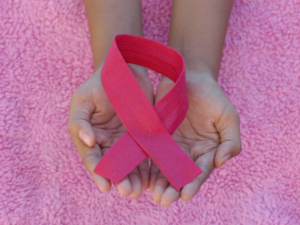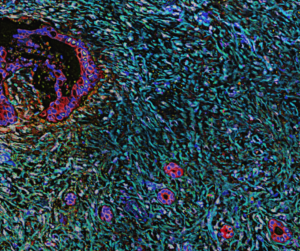Fatima Khan, PharmD, and Ila M. Saunders, PharmD, BCOP
Chronic graft-vs-host disease (cGVHD) is one of most common, yet severe, consequences of allogeneic hematopoietic stem cell transplantation. Occurring in up to 70% of patients, cGVHD is the leading cause of non-relapse mortality after allogeneic transplantation. Two new agents, belumosudil (Rezurock, Kadmon Pharmaceuticals) and ruxolitinib (Jakafi, Incyte), have demonstrated efficacy in treating patients with steroid-refractory chronic GVHD (cGVHD).1,2
Belumosudil is an oral selective rho-associated coiled-coil containing protein kinase-2 (ROCK2) inhibitor.3 Inhibition of the ROCK2 pathway reduces multi-organ fibrosis, one of the major complications of cGVHD.3 Belumosudil was FDA-approved in July 2021 for use in adult and pediatric patients aged 12 years and older with cGVHD following failure of at least two prior lines of systemic therapy.
Approval of belumosudil was based on the phase 2 ROCKstar (KD025-213) trial in which patients with previously treated cGVHD were randomized to belumosudil at 200 mg orally daily (n = 66) or 200 mg orally twice daily (n = 66).3 Previous treatment was defined as at least 2 to 5 prior lines of treatment. The trial established a primary efficacy endpoint of best overall response rate (ORR), defined as the proportion of subjects who achieved complete response (CR) or partial response (PR).
Baseline characteristics were similar across each treatment group. Upon screening, 67% of patients had severe disease, 52% had involvement of four or more organs, 78% were refractory to their last therapy, and the median prior lines of therapy was 3. Patients were excluded if they experienced a relapse of their underlying malignancy, had a National Institutes of Health (NIH) lung symptom score of 3, developed lymphoproliferative disease following transplant, or were already receiving treatment with ibrutinib.
Results of the study demonstrated that the overall response rate (ORR) in the once daily belumosudil group was 75% (95% CI, 63-85%) through cycle 7, day 1. The median time from diagnosis to belumosodil initiation was 25 months, the median time to first response was 1.8 months (95% CI, 1-1.9) and the median duration of response (first response to progression, death, or new therapies for chronic GVHD) was 54 weeks. A reduction of corticosteroid (CS) dose was seen in 65% of subjects while being treated with belumosudil. The mean CS dose reduction was 54% (n=237 responders) and 21% of subjects were able to discontinue CS therapy.
Key points to consider when prescribing and administering belumosudil:
- Dose: belumosudil 200 mg orally daily
- Indication: cGVHD after failure of at least 2 prior lines of systemic therapy
- Drug interactions: increase belumosudil to 200 mg orally twice daily with strong CYP3A inducers and/or proton pump inhibitors; no dose adjustments needed for strong 3A4 inhibitors.
- Common adverse reaction: infections, nausea, diarrhea, dyspnea, cough, edema, hemorrhage, abdominal pain, asthenia
- Take with food: Cmax and AUC increase following administration with a high-fat and high-calorie meal.
- May cause fetal harm: females of child-bearing age should be advised of risk to fetus and encouraged to use contraception.
Another agent, ruxolitinib, recently showed promise in the treatment of cGVHD. Approved in 2019 for acute GVHD (aGVHD) based on results from the REACH1 trial, ruxolitinib is a JAK1-JAK2 inhibitor, halting a pathway that leads to inflammation and fibrosis in both aGVHD and cGVHD.4 In the phase 3 REACH3 trial, patients with steroid-refractory or -dependent cGVHD showed significantly improved outcomes while on ruxolitinib compared to best available therapy (BAT). This phase 3 multicenter trial randomized 329 patients to ruxolitinib at 10 mg orally twice daily or BAT from a list of 10 common options.5
Approximately 42.9% of patients had moderate cGVHD, 56.5% had severe cGVHD, 71.4% had glucocorticoid-refractory disease, and 28.6% had glucocorticoid-dependent disease. The primary endpoint was ORR, defined as complete or partial response, at cycle 7, day 1. Secondary endpoints included change in the modified Lee cGVHD symptom scale score at cycle 7, day 1, rate of failure-free survival (FFS) until 36 months, best overall response (BOR), duration of response (DOR), and overall survival.
Results demonstrated substantial improvement after 24 weeks, with an ORR of 49.7% in the ruxolitinib group vs 25.6% (OR 2.99, P < 0.001) in the BAT group. Additionally, the BOR at week 24 was seen in 76.4% of patients in the ruxolitinib arm vs 60.4% in the BAT arm (95% CI, OR 2.17). Results in other key secondary endpoints, such as FFS, were also clinically improved in the ruxolitinib group. Ruxolitinib showed improved outcomes regardless of the individual organs that were affected at baseline. The safety profile seen in REACH3 was similar to adverse effects observed in prior clinical trials including thrombocytopenia, anemia, neutropenia, and pneumonia.4,5,6
The results of REACH3 demonstrating the benefit of ruxolitinib in the treatment of steroid-refractory cGVHD coupled with the recent approval of belumosudil are encouraging and allow for hope in treating this serious, life-threatening complication for this delicate patient population.
References:
- Rezurock (belumosudil). Package insert. Kadmon Pharmaceuticals, LLC; 2021.
- Jakafi (ruxolitinib). Package insert. Incyte Corporation; 2011.
- Corey S Cutler, Stephanie J Lee, Sally Arai, et al. Belumosudil for Chronic Graft-versus-Host Disease (cGVHD) After 2 or More Prior Lines of Therapy: The ROCKstar Study. Blood 2021; blood.2021012021. doi: https://doi.org/10.1182/blood.2021012021
- Jagasia M, Perales MA, Schroeder MA, et al. Ruxolitinib for the treatment of steroid-refractory acute GVHD (REACH1): a multicenter, open-label phase 2 trial. Blood. 2020;135(20):1739-1749. doi:10.1182/blood.2020004823
- Zeiser R, Polverelli N, Ram R, et al. Ruxolitinib for Glucocorticoid-Refractory Chronic Graft-versus-Host Disease. N Engl J Med. 2021;385(3):228-238. doi:10.1056/NEJMoa2033122
- Zeiser R, von Bubnoff N, Butler J, et al. Ruxolitinib for Glucocorticoid-Refractory Acute Graft-versus-Host Disease. N Engl J Med. 2020;382(19):1800-1810. doi:10.1056/NEJMoa1917635

Fatima Khan, PharmD
PGY-1 Pharmacy Practice Resident – UC San Diego Health

Ila M. Saunders, PharmD, BCOP
Health Sciences Associate Clinical Professor – Skaggs School of Pharmacy and Pharmaceutical Sciences







